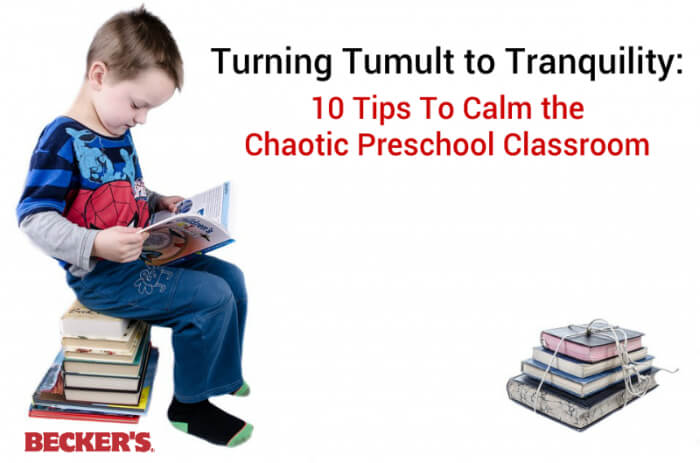10 Tips To Calm the Chaotic Preschool Classroom

The chaotic classroom causes feelings of unrest in all involved with it - the children, teachers, and families. Every teacher will be, in my opinion, fortunate enough to have “that group” of children at some point in their teaching career- the group that constantly keeps teachers on their toes as they present every challenging behavior or habit, and with frequency. While it is often one of the most transformative times for a teacher, it can be helpful to have a handful of strategies at the start of the school year to empower teachers to start off on the “right foot”.
1. Structure brings serenity!
A structured classroom, with consistent routines and expectations, does not provide as many opportunities for challenging behaviors to arise. In particular, teachers should ensure that the materials available to children are engaging and interesting to them, that teacher-guided activities are short and exciting, and that they always have a new idea or activity up their sleeve! With that being said, however, it is important to provide children with appropriate opportunities to exert their power. For instance, have choices of activities for children to choose from, rather than expecting them to take on one activity at a time. To the same effect, avoid offering choices when there aren’t any.
For instance, if a child is calling out repeatedly, asking them a question like, “Would you like to tell me about that later?” leaves the answerer open to the opportunity of saying, “No!” Instead, the teacher can tell the child that they may linger back at the end of circle time to tell the teacher all of the exciting things that they have to share. You can be sure that the child will come up to you at the end to chat, as they rarely forget an invitation like this!
2. A picture is worth 1000 words!
Picture rules and schedules are a way of helping children to understand what is expected and what is happening each day, rather than relying solely on their auditory comprehension of the information. Children can seek out these photos to see “what’s next” or to enforce the rules with one another instead of asking the teacher.
3. Reward positive behavior!
Children love to be acknowledged for doing what they’re supposed to do. When teachers compliment appropriate behavior rather than attempt to punish negative behavior, children exhibiting negative behaviors are more likely to right their behaviors, as they want to earn the attention that the other children are getting. “I see so-and-so putting all of the play food back into baskets and being such a helpful classmate!” can go much farther than, “So-and-so, stop jumping around the dramatic play center and clean up all of the toy food!”
4. Banking Time!
Many teachers have heard about the idea of a child’s “emotional piggy bank”- we want to make more deposits or positive interactions, than withdrawals, or negative interactions, with children throughout the day. When teachers set aside quality time for each child in the class, but especially those with challenging behaviors, they are able to make large deposits into children’s “emotional piggy banks”, building a strong relationship and connection to each child. Click here for more information on this strategy.
5. Consequences must be logical!
Ensure that, when discipline is necessary, you are offering logical consequences to the offense. Many teachers immediately jump to take away children’s outdoor play time - the time that they need most. Yet, much time often passes between playtime and outdoor time, and the consequence is no longer tied to the child’s action. For instance, a logical consequence for a child who throws a tantrum and dumps a cup of milk on the floor would be for the child to clean up the spilled milk after they’ve calmed down a bit.
6. Adopt a Social-Emotional curriculum!
Social-Emotional curricula explicitly teaches children to identify their emotions, to problem solve, to utilize social skills and to self-soothe, in a context outside of the emotionally charged “heat of the moment”. Programs that implement these types of curricula consistently and on a daily basis, through both explicit instruction and in play with children, often successfully eliminate many troublesome behaviors and interactions in the classroom.
7. Big Body Play!
Giving children the opportunity to exert themselves physically in the classroom, in a safe way, helps them to not only expel extra energy, but to collaborate with each other, to learn limits, and even gain academic skills! Click here for more information on the use of this strategy in the classroom.
8. Allow children to take ownership of the classroom!
When teachers create jobs for the children in the classroom, they are helping children to take ownership and responsibility of the classroom environment. It is important to ensure that each child has a job in the classroom to facilitate continued feelings of accountability. Jobs in the early childhood classroom can include: lunch helpers, door holders, line leader, line caboose, gardener (to water plants), meteorologist (to tell about the weather), lunch helper, center organizer (making sure that each center gets cleaned up correctly), documentarian (taking pictures with a camera or an iPad of portions of the day), and so forth.
9. Interesting and appropriate activities!
In order for children to want to engage in the routines of the day, teachers must provide them with activities that are both tailored to their interests, and modifiable to meet each child’s level of development and ability. Trying to encourage a child who prefers to exclusively play with trucks in the block center to write their name with a pen and paper will most likely not be effective. However, if you encourage the child to trace large letters of their name with a truck on the carpet, or to roll a small truck in paint and then to use the tires to roll their name onto a piece of paper, the child would be more apt to attend to, and engage with, the activity at hand.
10. Take time for yourself!
In the moments where the chaos of the room becomes overwhelming, it is essential for teachers to recognize their feelings, and to take the time to do so. This might mean taking a few moments to take deep breaths and to calm down, to step out and cry, or to take a time out when dealing with a challenging child, asking another teacher in the room to step in for a moment. Creating action plans for self-care is a helpful tool for teaching teams to ensure that no one experiences extreme feelings of being overwhelmed, inadequate, or burnt out. By ensuring that, as a team, you have each others’ best interests at heart and, therefore, you are willing to tag team stressful situations to alleviate the trouble, you will create a stronger and more energetic teaching partnership.
 Zaina Cahill, Pre-K Regional Instructional Specialist for the School District of Philadelphia, is a graduate of New York University (B.S. in ECE and Special Education) and Walden University (M.S.Ed. in Elementary Reading and Literacy), and has worked in a variety of capacities in the field of education working with toddler through elementary school children and their families, including children with special needs. In particular, Zaina has a passion for working to promote diversity, equity, and inclusion in the education environment. In Pennsylvania, Zaina holds Level 2 teaching certification in ECE, as well as PQAS (PA Quality Assurance System) certification to offer professional development. In addition, she is a certified CLASS observer (Infant, Toddler, PreK). Zaina is also adjunct faculty at Arcadia University, in the school’s graduate program for Early Childhood Education. Zaina is a member of the NAEYC Affiliate Advisory Council, the Exchange Leadership Institute, and the Philadelphia Race Matters and Cultural Competency Learning Circle. In 2016, Zaina was an honoree in attendance at the White House Teacher of the Year Event, hosted by Barack Obama, and has offered testimony in congressional hearings advocating for children and early childhood educators. In addition to presenting at various local, state, and national conferences, Zaina has also made a number of written contributions to blogs and education publications.
Zaina Cahill, Pre-K Regional Instructional Specialist for the School District of Philadelphia, is a graduate of New York University (B.S. in ECE and Special Education) and Walden University (M.S.Ed. in Elementary Reading and Literacy), and has worked in a variety of capacities in the field of education working with toddler through elementary school children and their families, including children with special needs. In particular, Zaina has a passion for working to promote diversity, equity, and inclusion in the education environment. In Pennsylvania, Zaina holds Level 2 teaching certification in ECE, as well as PQAS (PA Quality Assurance System) certification to offer professional development. In addition, she is a certified CLASS observer (Infant, Toddler, PreK). Zaina is also adjunct faculty at Arcadia University, in the school’s graduate program for Early Childhood Education. Zaina is a member of the NAEYC Affiliate Advisory Council, the Exchange Leadership Institute, and the Philadelphia Race Matters and Cultural Competency Learning Circle. In 2016, Zaina was an honoree in attendance at the White House Teacher of the Year Event, hosted by Barack Obama, and has offered testimony in congressional hearings advocating for children and early childhood educators. In addition to presenting at various local, state, and national conferences, Zaina has also made a number of written contributions to blogs and education publications.
The opinions, representations, and statements made within this guest article are those of the author and not of Becker’s School Supplies as a whole. Any copyright remains with the author and any liability with regard to infringement of intellectual property rights remain with them. The company accepts no liability for any errors, omissions or representations.
